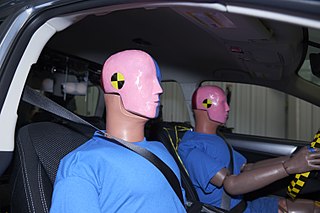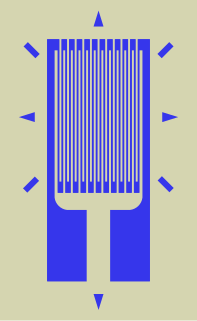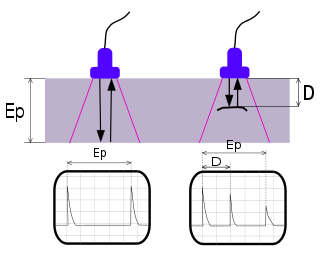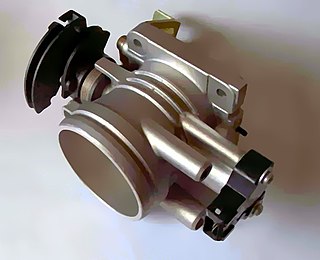Instrumentation is a collective term for measuring instruments used for indicating, measuring and recording physical quantities, and has its origins in the art and science of scientific instrument-making.

The technical meaning of maintenance involves functional checks, servicing, repairing or replacing of necessary devices, equipment, machinery, building infrastructure, and supporting utilities in industrial, business, governmental, and residential installations. Over time, this has come to often include both scheduled and preventive maintenance as cost-effective practices to keep equipment ready for operation at the utilization stage of a system lifecycle.

A crash test dummy is a full-scale anthropomorphic test device (ATD) that simulates the dimensions, weight proportions and articulation of the human body, and is usually instrumented to record data about the dynamic behavior of the ATD in simulated vehicle impacts. The Crash Test Dummy is widely used by researchers and automobile companies to predict the biomechanics, force, impact, and injury of a human being in an automobile crash. This data can include variables such as velocity of impact, crushing force, bending, folding, or torque of the body, and deceleration rates during a collision for use in crash tests. The more advanced dummies are sophisticated machines designed to behave as a human body and with many sensors to record the forces of an impact; they may cost over US$400,000.

A strain gauge is a device used to measure strain on an object. Invented by Edward E. Simmons and Arthur C. Ruge in 1938, the most common type of strain gauge consists of an insulating flexible backing which supports a metallic foil pattern. The gauge is attached to the object by a suitable adhesive, such as cyanoacrylate. As the object is deformed, the foil is deformed, causing its electrical resistance to change. This resistance change, usually measured using a Wheatstone bridge, is related to the strain by the quantity known as the gauge factor.
On-board diagnostics (OBD) is an automotive term referring to a vehicle's self-diagnostic and reporting capability. OBD systems give the vehicle owner or repair technician access to the status of the various vehicle subsystems. The amount of diagnostic information available via OBD has varied widely since its introduction in the early 1980s versions of on-board vehicle computers. Early versions of OBD would simply illuminate a malfunction indicator light or "idiot light" if a problem was detected but would not provide any information as to the nature of the problem. Modern OBD implementations use a standardized digital communications port to provide real-time data in addition to a standardized series of diagnostic trouble codes, or DTCs, which allow one to rapidly identify and remedy malfunctions within the vehicle.

Residual stresses are stresses that remain in a solid material after the original cause of the stresses has been removed. Residual stress may be desirable or undesirable. For example, laser peening imparts deep beneficial compressive residual stresses into metal components such as turbine engine fan blades, and it is used in toughened glass to allow for large, thin, crack- and scratch-resistant glass displays on smartphones. However, unintended residual stress in a designed structure may cause it to fail prematurely.

Ultrasonic testing (UT) is a family of non-destructive testing techniques based on the propagation of ultrasonic waves in the object or material tested. In most common UT applications, very short ultrasonic pulse-waves with center frequencies ranging from 0.1-15 MHz, and occasionally up to 50 MHz, are transmitted into materials to detect internal flaws or to characterize materials. A common example is ultrasonic thickness measurement, which tests the thickness of the test object, for example, to monitor pipework corrosion.

A throttle position sensor (TPS) is a sensor used to monitor the air intake of a engine. The sensor is usually located on the butterfly spindle/shaft so that it can directly monitor the position of the throttle. More advanced forms of the sensor are also used, for example an extra closed throttle position sensor (CTPS) may be employed to indicate that the throttle is completely closed. Some engine control units (ECUs) also control the throttle position electronic throttle control (ETC) or "drive by wire" systems and if that is done the position sensor is used in a feedback loop to enable that control.
OBD-II PIDs are codes used to request data from a vehicle, used as a diagnostic tool.
In electrical and electronic engineering, a current clamp or current probe is an electrical device with jaws which open to allow clamping around an electrical conductor. This allows measurement of the current in a conductor without the need to make physical contact with it, or to disconnect it for insertion through the probe. Current clamps are typically used to read the magnitude of alternating current (AC) and, with additional instrumentation, the phase and waveform can also be measured. Some clamps meters can measure currents of 1000 A and more. Hall effect and vane type clamps can also measure direct current (DC).
A particle counter is an instrument that detects and counts physical particles.

A cable harness, also known as a wire harness, cable assembly, wiring assembly or wiring loom, is an assembly of electrical cables or wires which transmit signals or electrical power. The cables are bound together by straps, cable ties, cable lacing, sleeves, electrical tape, conduit, a weave of extruded string, or a combination thereof.
Laser peening (LP), or laser shock peening (LSP), is a surface engineering process used to impart beneficial residual stresses in materials. The deep, high magnitude compressive residual stresses induced by laser peening increase the resistance of materials to surface-related failures, such as fatigue, fretting fatigue and stress corrosion cracking. The physics of the laser shock peening process can also be used to strengthen thin sections, work-harden surfaces, shape or straighten parts, break up hard materials, compact powdered metals and for other applications where high pressure, short duration shock waves offer desirable processing results.
Metal Improvement Company (MIC) is a company specializing in metal surface treatments. Metal Improvement Company LLC is a business unit of the Surface Technologies Division of Curtiss-Wright Corporation.

Tensile testing, also known as tension testing, is a fundamental materials science and engineering test in which a sample is subjected to a controlled tension until failure. Properties that are directly measured via a tensile test are ultimate tensile strength, breaking strength, maximum elongation and reduction in area. From these measurements the following properties can also be determined: Young's modulus, Poisson's ratio, yield strength, and strain-hardening characteristics. Uniaxial tensile testing is the most commonly used for obtaining the mechanical characteristics of isotropic materials. Some materials use biaxial tensile testing.
Robustness validation is a skills strategy with which the Robustness of a product to the loading conditions of a real application is proven and targeted statements about risks and reliability can be made. This strategy is particularly for use in the automotive industry however could be applied to any industry where high levels of reliability are required
Small arms ammunition pressure testing is used to establish standards for maximum average peak pressures of chamberings, as well as determining the safety of particular loads for the purposes of new load development. In metallic cartridges, peak pressure can vary based on propellant used, primers used, charge weight, projectile type, projectile seating depth, neck tension, chamber throat/leade parameters. In shotshells, the primary factors are charge weight, projectile weight, wad type, hull construction, and crimp quality.

Peening is the process of working a metal's surface to improve its material properties, usually by mechanical means, such as hammer blows, by blasting with shot or blasts of light beams with laser peening. Peening is normally a cold work process, with laser peening being a notable exception. It tends to expand the surface of the cold metal, thereby inducing compressive stresses or relieving tensile stresses already present. Peening can also encourage strain hardening of the surface metal.


















